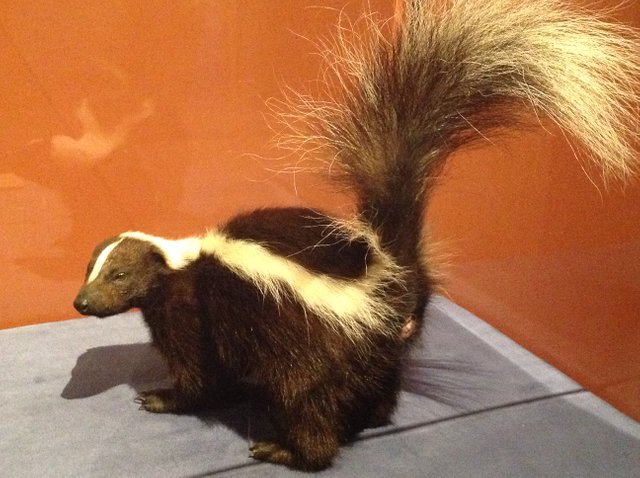Animal Series: Striped Skunk - mephitis mephitis
The Striped Skunk is the most common of the four skunk varieties that inhabit North America. Its range is Southern Canada, most of the continental U.S. and Northern Mexico. DNA analysis has placed all skunks into their own family; at one time, they were considered a member of the weasel family. They are a well known animal and part of our culture in children's books and cartoons.
Striped skunks are black, cat-sized mammals with a stripe that starts at the back of their head, splits in two and continues along each side of their back and down their bushy tail. There is also a small stripe down their nose. They have semi-webbed feet with long straight claws that are meant for ripping into stumps in search of food like grubs. As opportunistic omnivores, they will also eat fallen fruit, the young of other small mammals, amphibians, and even young birds. In cities, they will happily eat from garbage bins.

Due to their short legs, skunks can't outrun their predators. Instead, they rely on an extremely offensive odor they spray from small scent glands under their tail. It stops a predator in its tracks often coughing and choking. A skunk can spray up to 6 metres (almost 20') and the odor is detectable up to 1 km (.62 miles) downwind.
They live in mixed forest and grasslands in the abandoned dens of other animals. However, there are actually a greater concentration of skunks living in cities where they might reside under porches, refuse heaps, and garden sheds.
Skunks feed all summer and hibernate during the winter. They may awake as early as February to start breeding. In May, the babies, called kits, are usually born into a litter of four to six. Although they are born furless, they have their thick coats in thirteen days.
Skunks are pretty shy and generally avoid people. We or our pets are mostly likely to encounter them at dusk when our schedules overlap with these nocturnal creatures.
Being Sprayed!
I was once walking a very large dog that decided to run towards the movement he spotted in deep rough grass at the side of the road. I only outweighed the dog by five pounds and immediately yelled and tried to stop him as he dragged me closer. Then he stopped suddenly and I spotted it. The skunk's tail was raised and he was disappearing into the grass still 3 metres (10') away. I was very relieved, thinking we had missed a close one.
Then I smelled it.
The dog and his end of the leash had been sprayed while I was somehow spared, and now he needed a bath. Worse, we were taking a 7 hour car ride together in the morning. You don't want to be in a confined space with that smell. Even skunks don't like it as they won't spray within their den.
We ran home so I could bathe him. As we entered the house, I yelled "Sit! Stay!" and ran upstairs to change, disrobing on the way. As I came back down, the scent was already rising up the stairwell.
An old wives' tail said that tomato would remove skunk odor. I quickly searched through the pantry and chose clamato juice over stewed tomatoes, and grabbed the dish detergent. And there I was, bathing a dog in my backyard at 11 pm.
Surprisingly, skunks make great pets when descented although owning wild animals should not be encouraged. In the wild, they live for 2-4 years but will live to 15 in captivity.
The photo of the stuffed skunk was taken in the Mammal Gallery at the Canadian Museum of Nature.
References
Canadian Museum of Nature - Mammal Gallery
Striped Skunk
Images
Photo from the iPad of @kansuze.

@kansuze